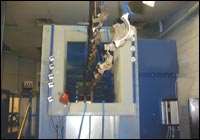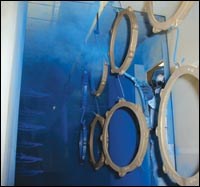Powder Coating Filter Saves Time & Money
Because of the high film builds required for its parts, Smith-Blair sprays an average of 400 lb of powder per day per booth. To keep quality high, the company has installed a new powder coating filter…
Smith-Blair, Inc. (a division of UK-based Invensys) manufactures products used to join, repair and restrain all types of industrial metal pipe. Chief among the company’s specialties is pipe product for the global water, natural gas and “oilpatch” markets. The company’s Texarkana, AK, facility specializes in water pipe; other facilities are located in Uniontown, PA, and Orlando, FL.
Smith-Blair Texarkana makes an extra-ordinary range of product. According to production manager Charles Cross, “Just about everything from 0.75 to 50+ inches.” The latter is used for work environments that demand high salt spray and Holiday test ratings.
Equally extraordinary is the company’s powder coating operation, where film builds up to 16 mils are standard. And, the expectation is that the powder finish will last 40 years or more. “In the pipe industry,” said Mr. Cross, “we don’t do ‘normal’ powder coating. Specifications range from 4-5 mils to as high as 16 mils, which obviously puts an incredible amount of powder through the booth and creates some unique challenges.” A cold spray technique is used for a few products, such as repair clamps, whose build specifications are in the low (4-5 mils) range, but preheating is used for all other products to prevent flaws from outgassing and to facilitate consistency on the higher end of the build spectrum.
Smith-Blair operates three main powder booths, each with a 52-inch high and 40-50-inch wide opening, and one spray-to-waste booth for fast color changes. Production, according to Mr. Cross, typically includes “large and small couplings, generally 14,000-15,000 parts per day, plus some huge pipe sections and flanges. It’s a highly variable mix of product.” The booths operate 9-10 hours per day, 6-7 days per week.
“From the beginning,” stated Mr. Cross, “our big challenge has been booth filtration.” Specifically, filter service life, which is confounded by the sheer quantity of the powder in the booth. Each booth houses 13 guns, and powder consumption can average 400 lb of powder per day, per booth. Two other factors also contribute to the problem. “These booths were engineered by the OEM at a lower cfm than you’d have if film builds were more typical,” explained Mr. Cross.
“Also, there’s a lot of heat to deal with. The powder wants to float and you can get into problems with webbing—where overspray creates an effect that looks like baked-on spider webs. In fact, the powder is partially cured as it contacts the heated parts, and that’s also true of the cartridges. So, these partially cured particles end up in the filters, and if the filter isn’t designed for this type of application, blinding is the result.
“The booth OEM’s poly-filter does a good job, and it gives us about 30 days in service. But it’s very expensive. My goal has been to find one that would give us that performance and service life, at an affordable cost. Since we converted from liquid to powder, I’ve tried out nine other filters. Eight of them, which seemed all pretty similar, lasted in our booth either two or three days. The ninth one, though, was a surprise.”
The “surprise” was a new powder cartridge technology developed by Chemco, Inc. Introduced at Powder Coating 2000, the technology, marketed as Pulsator-Plus, was engineered to perform at 99.9% efficiency at 2 microns. Its media, a proprietary spunbonded polyester hybrid, has a service life five to seven times longer than the cellulose cartridges it’s often compared to.
What’s most compelling, however, is that it is made using Advanced Dual DimplingTM, a manufacturing technique that imparts a dual (opposed) dimpling feature on individual filter pleats. This technique has the effect of increasing filter performance when the filter is operating under high load conditions. It also optimizes the efficiency of pulse cleaning and enhances filter capacity after pulsing.
The pleats of the cartridges used in powder booths naturally “pinch” at the top during operation, a phenomena which restricts airflow and reduces the total effective filter surface area. The double dimpling process prevents the pleats from compressing, so filtration can occur across 100% of the surface area. This aspect of the filter design also contributes to the cartridge being resistant to tearing and collapsing.
One other important distinction Mr. Cross observed, “Filter pleats typically ‘balloon’ to some extent during pulsing, which traps powder at the bottom of the pleat. This dimpling process apparently stiffens the filter media enough to prevent this unwanted effect.” The result is more effective cleaning.
The filter’s design uses unusually wide pleat spacing and allows 100% of the filter media to be used, since support bands, which typically cover part of the media, are not needed on this new cartridge design. “As a result,” stated Mr. Cross, “the cartridge has excellent release properties, and the powder retained within the cartridge is minimal—just 3-7 lb per filter.
“We found these cartridges let you back-pulse as low as 40 psi,” proclaimed Mr. Cross, “which probably saves half the energy needed to supply compressed air to pulse clean the cartridges. They’re also quiet and very environmental because they can be washed and re-used without reducing their effectiveness.”
Mr. Cross has found the technology to be equal to the OEM cartridge, with each capable of achieving target filtration result, and a service life averaging 30 days or more. Most important, Mr. Cross has achieved his cost savings goal. The Chemco cartridge saves Smith Blair $600 per changeout—more than $7,000 per year. “Honestly, too,” said Mr. Cross, “my time’s important—and short. It’s worth at least again as much as the actual dollars we save.
“I took it as a personal challenge when the booth people told me their filter was ‘top of the line’ and I wouldn’t be able to beat it. Well, we proved there was another filter that could give us the 30-day life we wanted and not require more than one cleaning of the final filter. Obviously, we like the ongoing cost savings, and we think it’s also good for everyone that the OEM now knows they aren’t the only game in town.”
RELATED CONTENT
-
Anodizing Vs. Powder Coat
I am an engineer on a large yacht build project and urgently need information and advice on choosing a finish for the aluminum deck plates in the engine room.
-
Touch-up Options for Powder Coated Parts
Is it true that powder coating cannot be touched up? Powder coating expert Rodger Talbert offers options for powder coating touch-ups.
-
Masking for Surface Finishing
Masking is employed in most any metal finishing operation where only a specifically defined area of the surface of a part must be exposed to a process. Conversely, masking may be employed on a surface where treatment is either not required or must be avoided. This article covers the many aspects of masking for metal finishing, including applications, methods and the various types of masking employed.

















